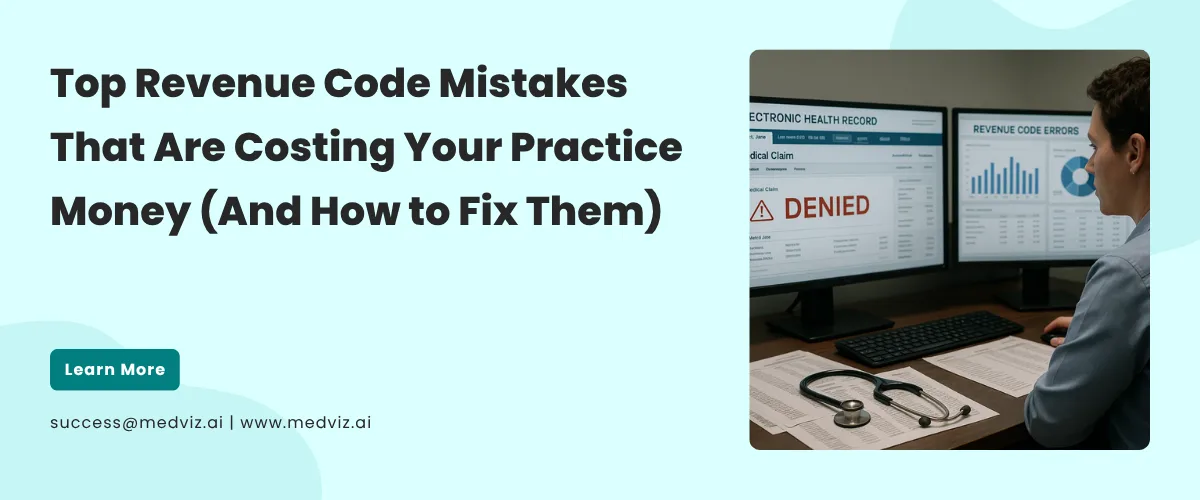When it comes to medical billing, even the smallest mistake can create significant financial setbacks. One of the most overlooked — yet costly — issues is incorrect use of revenue codes. These seemingly simple three-digit codes can be the silent killers of revenue, leading to claim denials, delayed reimbursements, compliance risks, and lost revenue that adds up fast.
In this guide, we’ll explore the most common revenue code mistakes, how they affect your bottom line, and the steps you can take to stop losing money. Whether you’re a billing manager, coder, or healthcare administrator, this article will help you understand the financial risks and how to address them before they damage your revenue cycle.
What Are Revenue Codes and Why They Matter in Medical Billing
Revenue codes are three-digit numbers used on the UB-04 claim form, primarily in hospital and facility billing. Each code represents a specific department, service, or type of charge provided during a patient’s visit. These codes allow insurers to understand where and how care was delivered — a critical factor in processing and reimbursing claims.
Examples of Common Revenue Codes:
- 0450 – Emergency Room
- 0270 – Medical/Surgical Supplies
- 0360 – Operating Room Services
Unlike CPT or HCPCS codes, which describe the specific procedure, revenue codes point to the setting or resource used. For instance, you might bill a CPT code for a chest X-ray but use revenue code 0320 to indicate that it occurred in the radiology department.
Incorrect revenue codes confuse payers, delay payments, and may trigger audits or outright denials — all of which chip away at your practice’s profitability.
The Real Cost of Revenue Code Errors
If you think a minor revenue code error is no big deal, think again. According to industry studies:
- 30% to 32% of denied claims are linked to billing and coding issues — including incorrect revenue codes.
- U.S. providers lose up to $125 billion annually due to revenue cycle inefficiencies, much of which stems from preventable coding mistakes.
- Roughly 86% of denials are avoidable, often tied to data entry and code selection errors.
In one real-world example, a health system in Indiana was forced to return $2.9 million after an audit revealed overuse of incorrect revenue codes tied to lab testing. And that’s just the financial fallout — reputational damage and compliance issues are harder to quantify.
Top 7 Revenue Code Mistakes That Are Costing You Money
Understanding the most frequent revenue code issues is your first line of defense. Let’s break down the top offenders:
1. Incorrect Revenue Code for Service Location
Using inpatient codes for outpatient services (or vice versa) is a common mistake. For example, billing 0360 (Operating Room Services) for a procedure done in an outpatient clinic can instantly lead to denial.
2. Misaligned Revenue Code and CPT/HCPCS Code
Your revenue code and procedure code must logically match. Billing 0450 (ER) alongside a CPT code for a psychiatric evaluation — when the service occurred in a behavioral health unit — will almost always be rejected.
3. Using Outdated or Deleted Revenue Codes
Payers update their requirements annually. Using obsolete revenue codes not only causes rejections but may also raise red flags during audits.
4. Missing or Incorrect Modifiers
Modifiers provide clarity about a service. If your revenue code requires a modifier and it’s missing or misapplied, the claim may be underpaid or denied.
5. Improper Bundling or Unbundling
Some services must be billed together under a single revenue code (bundling), while others must be billed separately. Mistakes in this area not only reduce reimbursement but may also look like fraudulent upcoding.
6. Upcoding or Downcoding Revenue Codes
Assigning a more complex (higher-paying) code without clinical justification (upcoding) is not only unethical — it’s risky. On the flip side, downcoding leaves money on the table.
7. Lack of Medical Necessity or Documentation
If a claim lacks documentation supporting the revenue code (especially for high-dollar items), auditors will reject it — and future claims may face increased scrutiny.
How Revenue Code Errors Affect Reimbursement and Compliance
Each of these mistakes contributes to:
- Delayed reimbursements and prolonged A/R cycles.
- Increased denial rates and rework, which costs staff time and resources.
- Compliance risk due to improper reporting — especially with Medicare and Medicaid.
- Damaged payer relationships and even pre-payment review flags, which slow down your cash flow.
Payers like Medicare and large commercial insurers use sophisticated systems to detect inconsistencies between revenue codes and procedures. Repeated errors can lead to increased audit frequency or recoupment requests.
5-Step Strategy to Prevent Revenue Code Mistakes
Avoiding these errors doesn’t require an overhaul — just a smarter workflow. Implement these five strategies to prevent lost revenue:
1. Automate Eligibility and Revenue Code Validation
Use RCM or billing software that includes real-time claim scrubbing and revenue code pairing rules for each payer.
2. Train Staff on Coding Updates and Guidelines
Hold quarterly coding refreshers to ensure your billing and coding team stays current with CMS changes and payer-specific requirements.
3. Conduct Internal Audits Monthly
Focus on high-volume departments and track patterns in revenue code-related denials. Fix trends before they escalate.
4. Update Codebooks and Reference Materials
Ensure all staff have access to the latest CPT, HCPCS, and revenue code manuals. Set a calendar reminder to review CMS updates each year.
5. Collaborate With Providers for Better Documentation
Encourage providers to document clearly and completely so the billing team can assign accurate revenue codes supported by clinical notes.
How AI and Technology Are Changing Revenue Code Accuracy
Advancements in AI and automated coding systems are transforming revenue code management. These tools analyze clinical documentation and EHR data to suggest accurate revenue code and CPT/HCPCS pairings in real time—often before claim submission.
By reducing manual errors, streamlining workflows, and improving compliance, these technologies help high-volume or multi-site practices minimize denials, prevent revenue leakage, and accelerate reimbursement.
Conclusion: Protect Your Revenue Before It Slips Away
Mistakes with revenue codes may seem small on the surface, but their ripple effect is massive — from lost revenue and delayed payments to audit risks and compliance penalties.
By recognizing the 7 most common errors, using smart tools, and educating your team, you can take control of your revenue cycle and start fixing leaks that may have gone unnoticed for years.
But you don’t have to tackle it alone.
Stop Letting Revenue Code Errors Drain Your Bottom Line
Incorrect revenue codes, claim denials, and compliance risks shouldn’t be eating away at your revenue. As payer rules grow more complex and audits become more aggressive, your billing strategy needs to be precise — and proactive.
At Medviz Systems, we help practices eliminate costly errors with smarter, data-driven revenue cycle solutions tailored to real-world coding and billing challenges.
📞 Speak directly with a revenue cycle strategist today at +1 (727) 214-2749
📧 Or email us anytime at success@medviz.ai
We don’t just clean up your claims — we decode revenue codes, reduce denials, and build workflows that protect your profits from the inside out.
Partner with Medviz — and take back control of your revenue integrity.



Leave a Reply